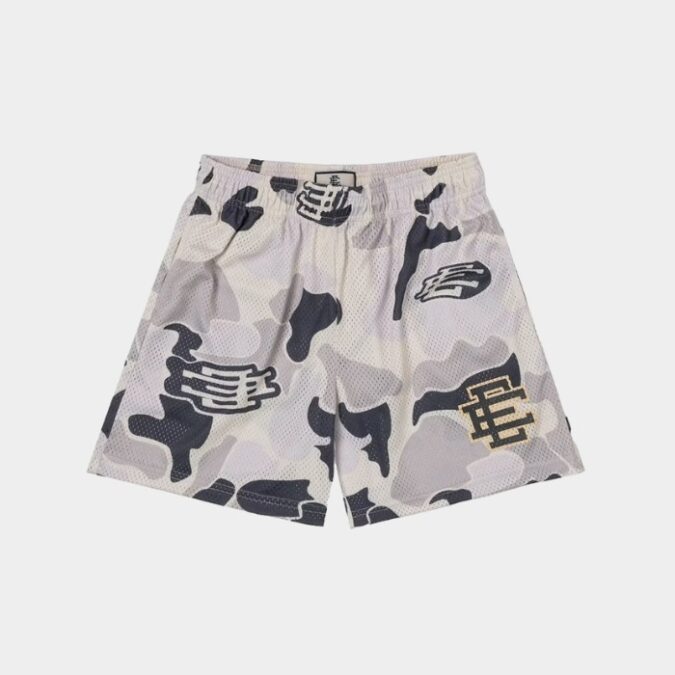You will see them walking through any large city in America today. Shorts inspired by basketball with such colors that they glow with it, sold by NBA stars and freshmen who have never even played basketball. Eric Emanuel shorts are no longer just sportswear, but they have redefined the way a whole generation perceives the casual world of fashion. These are not your typical gym shorts being used to wear on a daily basis. They are specifically crafted, retro-futuristic items that combine the nostalgia of the 1990s with the taste of street-style clothing, and they are taking over the US fashion in a manner that no one foresaw 5 years ago. Then how did shorts become the mainstay of a culture?
From Vintage Obsession to Fashion Revolution
Emanuel did not just wake up one day and decide to make shorts. It began with his true obsession with vintage sportswear, namely basketball apparel of the ’80s and ’90s. He used to waste hours searching through thrift shops and online auction sites, researching constructive methods and how some items he felt special about. His eponymous brand was started in 2015 after years of working in the fashion industry, and there was one simple idea he wanted to accomplish: to recreate the magic of classic basketball shorts with high-quality materials and contemporary manufacturing principles. Those initial releases sold mostly by word-of-mouth and Instagram, to a small but loyal following who felt that attention to detail. The Eric Emanuel shorts had passed into the mainstream streetwear awareness in less than three years and had moved beyond niche status.
Material Quality That Justifies the Price Tag
Let’s address the elephant in the room: these shorts typically retail between $120 and $180. That’s steep for what some people consider “just shorts.” But pick up a pair and the price starts making sense immediately. Emanuel uses high-grade mesh fabrics that breathe exceptionally well while maintaining structure and durability. The material weighs it, not that cheap synthetic feel you get from fast-fashion athletic brands or even minimalist pieces like Yeezy Gap. Double-stitched seams reinforce high-stress areas like the waistband and leg openings. The drawstring tips are metal, not plastic; they snap after a month. Screen-printed graphics use quality inks that don’t crack or fade after washing. Many pieces still get manufactured in New York, allowing for stringent quality control that mass-produced alternatives simply cannot match.
The Color Palette That Changed Everything
The majority of athletic shorts are available in expected colors: black, navy, grey, and potentially red, with luck. Emanuel gazed over such a landscape and felt there was no use in boring. His shorts come in color blends that allude to traditional NBA team uniforms: Lakers purple and gold and Knicks blue and orange and Bulls red and black and Celtics green and white. But he does not end at the plain and simple decisions. Manswears that on occasion and at times would never feature pastel pinks, lavender, mint green, sunshine yellow, suddenly became statement pieces. This courageous attitude towards color changed the way young men in America perceive their wardrobes. Donning vivid colors ceased to be feminine or daring and became stylish and self-assured. The Eric Emanuel shorts enabled it to be okay, even desirable, that guys should adopt a rich palette of colors that were outrageous only ten years prior.
Celebrity Endorsement That Felt Genuine
LeBron James wore those courtside during playoff games. Aime Leon Dore performed at festivals. Justin Bieber, Post Malone, Gunna, Lil Durk, the celebrity roster reads like a who’s who of contemporary culture. What separates these endorsements from typical brand partnerships? Most happened organically before any formal sponsorship arrangements existed. Athletes gravitated toward the shorts because they respected the basketball heritage and appreciated the quality. Rappers wore them because they fit naturally into the athletic-luxury aesthetic dominating hip-hop fashion. This organic adoption provided credibility that paid advertising simply cannot replicate. When fans saw their favorite artists choosing Eric Emanuel shorts without being contractually obligated, it validated the brand’s cultural relevance in a way that felt authentic rather than manufactured.
Limited Releases Creating Collector Mentality
Emanuel operates on a drop model, limited quantities released at specific times that typically sell out within hours. This isn’t artificial scarcity designed purely to drive hype. Production runs stay small because the brand maintains higher quality standards and manufactures significant portions domestically. You won’t find Eric Emanuel shorts at every mall or sports retailer. They drop through the brand’s website and select boutiques, then they’re gone. This exclusivity transforms the shorts from basic athletic wear into collectible items. Fans treat rare colorways and collaboration pieces the way sneakerheads approach limited-edition Jordans. The resale market reflects this mentality; certain shorts double or triple in value once sold out. That secondary market strength demonstrates genuine demand rather than temporary hype that evaporates after a season.
Collaborations That Elevated the Brand’s Profile
The Adidas collaboration which was launched in 2020, has made Eric Emanuel shorts available to a much broader audience without losing the high-end brand image. These were not just a pair of generic Adidas shorts with the name Emanuel printed on them, but with unique characteristics in design, which turned a tribute to both Emanuel and the brand. Then there was the McDonald’s partnership that literally exploded the internet. Golden arches on shorts and colorways inspired by Ronald McDonald created viral social media content and sold out immediately. Further alliance with New Era, Reebok, and other NBA teams strengthened the sports-heritage DNA at the core of the brand. It was not opportunistic at all since every collaboration was purposeful and broadened the reach of Emanuel without intertwining what made the shorts unique in the first place.
How Eric Emanuel Shorts Redefined Casual Masculinity
Before Emanuel, American men’s casual fashion existed in a fairly narrow lane. Jeans, chinos, maybe joggers if you were feeling adventurous. Shorts meant cargo shorts, athletic shorts for the gym, or basic chinos for summer. The idea of shorts as a legitimate fashion statement, something you’d intentionally style and coordinate with the rest of your outfit, barely existed outside niche streetwear circles. Emanuel changed that calculation entirely. His shorts became outfit centerpieces rather than afterthoughts. Guys started building looks around their shorts instead of treating them as default warm-weather options. This shift represents a broader transformation in how younger American men approach fashion, prioritizing self-expression and creativity over rigid traditional masculinity that limits style choices.
The Fit That Actually Works for Real Bodies
Fit can make or break any piece of clothing and Emanuel tacked down the proportions. The shorts are baggy just above the knee, not too long like early 2000s basketball shorts, not unnaturally short like running shorts. The leg openings are not too tight, allowing room to accommodate athletic builds without appearing baggy on thinner frames. Elastic waistbands that come with a draw string can be fitted to fit customarily and not just by sizing. This flexibility implies that the shorts can be worn by people of various body types and styles. They can be put on with high-top sneakers and a vintage tee to give the basketball ’90s look. Combine them with designer sneakers and oversized hoodies to wear in the street. Bring jeans, add a button-up, and luxury slides to make it elevated casual. The shorts are not so demanding, but adapting.
Cultural Impact Beyond Just Fashion
Eric Emanuel shorts are not a piece of clothing. They are a window onto millennial and Gen Z nostalgia, alluding to a time of basketball that has existed before social media but continues to exist in highlight reel and retro culture form. They close the age disparity as older heads who recall having such shorts as a teenager in the 90s relate to younger fans who are just finding such a style now. The shorts also represent the violation of the boundaries between sportswear and casual fashion, which is a trend that has redefined the whole American clothing market. Athleisure went crazy a few years back, yet Emanuel showed that you could respect the sports tradition at the same time, not compromising style and not being satisfied with generic performance clothing. Yet, that ratio of authenticity and fashion-savvy thinking is his contribution to the culture.


